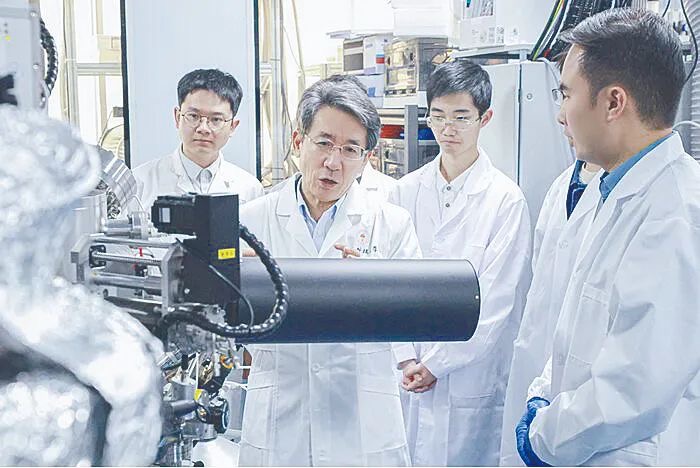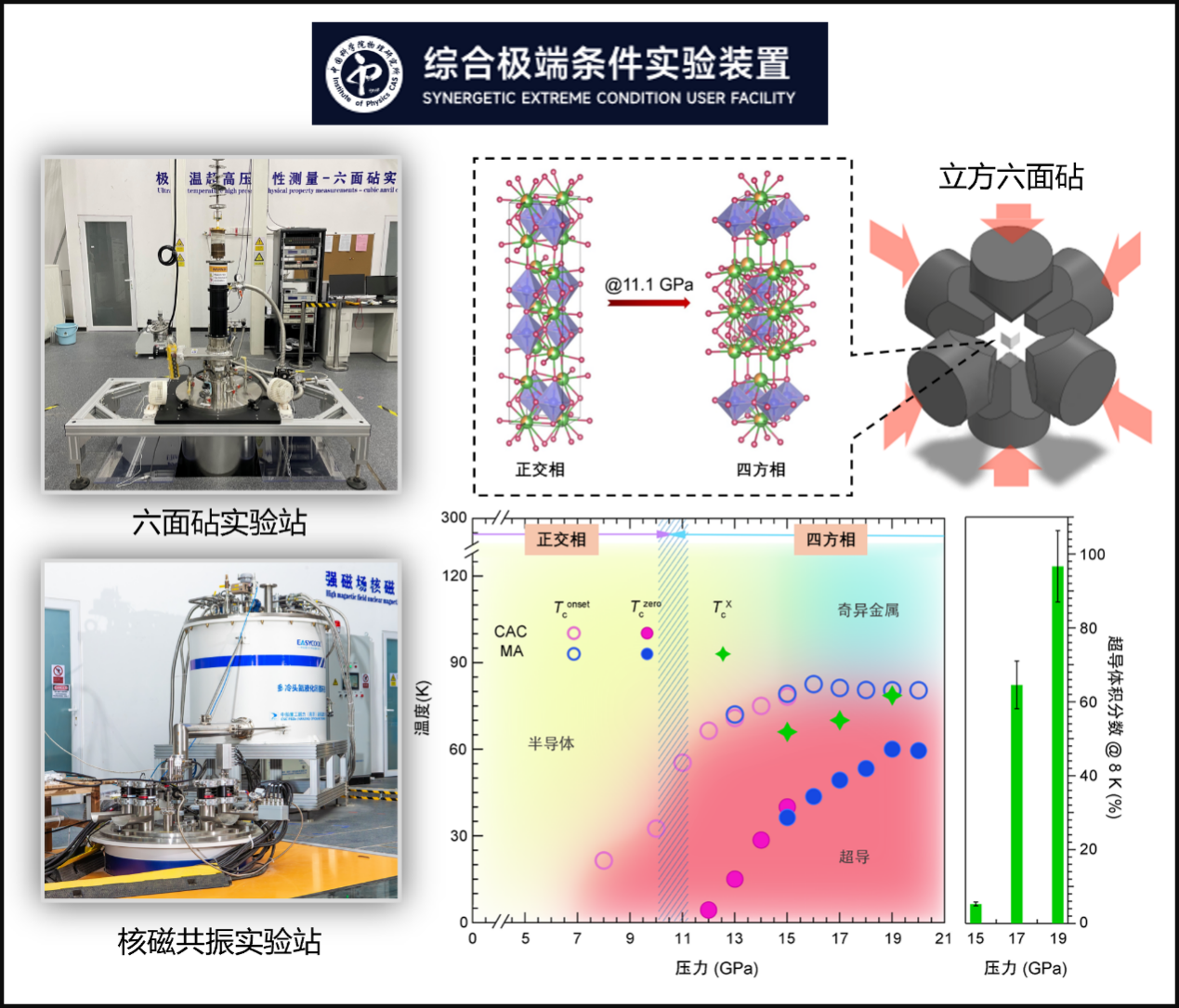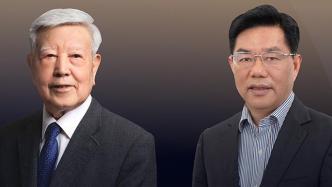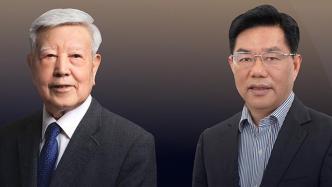
· "Our current technological development is divided into three main categories, one is energy, information, and biotechnology. Superconducting materials can support both energy technology and information technology. Human civilization can be divided by materials. Room temperature superconducting materials It can become a landmark material to divide the civilization period of human society."
" I think that in order to find room-temperature superconductors, we need to start with a new mechanism. This is a direction we are working on now."
It has been 112 years since the discovery of superconductivity in 1911 by Heike Camerin Onnes, a professor at Leiden University in the Netherlands. Although it has only a history of more than a hundred years, there have been 10 scientists who have directly won the Nobel Prize through superconductivity research.
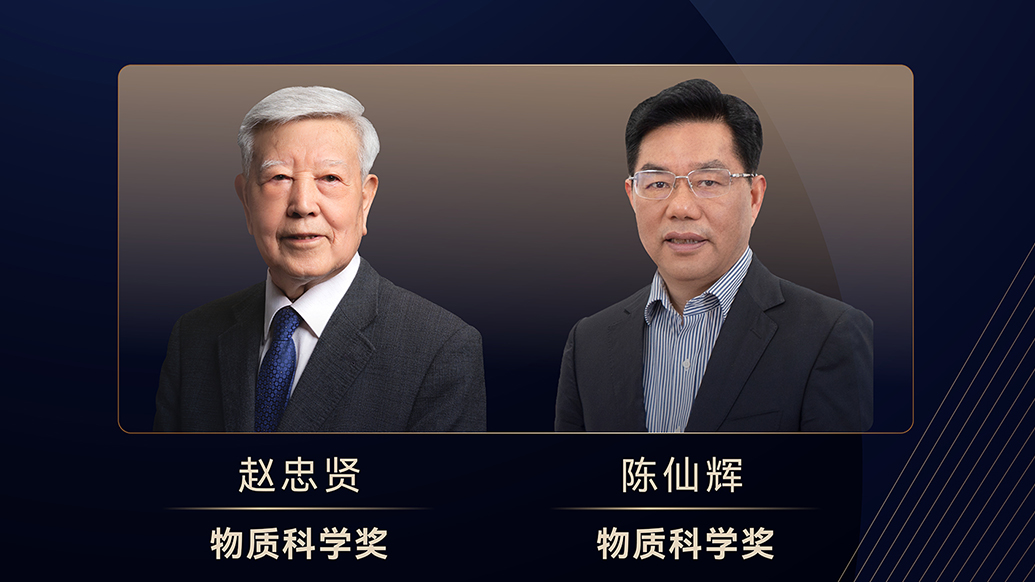
82-year-old Zhao Zhongxian and 60-year-old Chen Xianhui were awarded the 2023 Future Science Award-Physical Science Award.
On the morning of August 16, the winners of the 2023 Future Science Awards were announced. Due to their groundbreaking discovery of high-temperature superconducting materials and their pioneering contributions to the systematic increase of transition temperature, two key figures in the field of superconductivity in my country—82-year-old Zhao Zhongxian and 60-year-old Chen Xianhui were awarded the "Matter Science Award".
There are two main types of high-temperature superconducting materials (superconductors with a critical temperature above 40K, which is minus 233°C): copper oxide superconductors and iron-based superconductors.
In terms of copper oxides, the team led by Zhao Zhongxian independently discovered the first superconducting material in the liquid nitrogen temperature region. In terms of iron-based superconductors, Chen Xianhui's research group first raised the superconducting transition temperature above the Macmillan limit, proving that iron-based superconductors are indeed unconventional high-temperature superconductors, and Zhao Zhongxian's research group created and maintained the superconducting transition in bulk materials. temperature records.
While increasing the superconducting transition temperature, Zhao Zhongxian and Chen Xianhui have done a lot of systematic research on the physical mechanism of high-temperature superconductivity, which has promoted the development of high-temperature superconductivity in the past few decades.
After the list of winners was announced, Zhao Zhongxian and Chen Xianhui accepted an interview with Thepaper.cn (www.thepaper.cn), talking about the past research process and future research direction, and directly responded to the current hotly discussed "room temperature superconductor material LK-99" "Research.
Superconductivity was discovered 112 years ago, and many Nobel Prize winners have been born
On July 10, 1908, Professor Heike Kamering Onnes of Leiden University in the Netherlands was conducting his low-temperature physics research in the laboratory as usual. But what is different is that on this afternoon, he liquefied helium for the first time , setting a new record for man-made low temperature at -269°C (4.2K, K is the international unit of temperature, Kelvin).
On this day, the door to the world of extremely low temperature physics is opened to human beings. After that, in 1911, Onnes, who was honored by his colleagues as "Mr. Zero" (the lowest temperature humans can reach is absolute zero), cooled mercury to below 4.2K. At this time, he measured that its resistance dropped to almost zero. This was the discovery of the phenomenon of superconductivity, which means that the resistance of a material becomes zero below a certain temperature (the critical temperature), which means that the transmission of electricity will minimize losses.
Electrical phenomena are always accompanied by magnetic phenomena. In addition to the characteristic of zero resistance in superconducting phenomena, complete diamagnetism is another important characteristic. Magnetic resonance imaging and superconducting maglev trains are all developed based on it. For more than 100 years, scientists have continued to search for superconducting materials with higher critical temperatures. Only such materials can reduce costs and be used on a large scale.
It can be said that there are several key nodes in the development of the field of superconductivity: the establishment of superconductivity theory, the emergence of high-temperature superconductors, and the exploration of room-temperature superconductivity that has now received widespread attention.

Room temperature superconducting materials have been called the last "holy grail".
Darkest hour: Theoretical upper limit of -233.15°C
Since the discovery of superconductivity, how to explain the physical mechanism behind the phenomenon has become a key issue. In this process of exploration, the more famous theories that emerged include the second-order phase transition theory, the London equation, the Pippa theory, the Ginzburg-Landau theory, and so on. The greatest influence on the subsequent development was the electron-phonon coupling theory (referred to as "BCS theory") proposed by American physicists John Bardeen, Leon Cooper and John Robert Schiffer in 1957.
The BCS theory holds that at low temperatures, electrons in metals form a special pairing state called Cooper pairs. Cooper pairs can interact with each other to form a coherent state that can flow unhindered, unaffected by impurities or lattice vibrations, and thus have zero resistance. At the same time, the Cooper pairs will also repel the external magnetic field, so that there is no magnetic induction inside the superconductor, which is the complete diamagnetism or Meissner effect.
However, in 1968, American physicist McMillan concluded based on the only BCS theory that successfully explained superconductivity at that time that the critical transition temperature of general superconductors could not be higher than 40K (about -233.15°C). Milan Limit". This is also the "darkest moment" in the field of superconductivity, and the entire field has entered a trough. Because if the "McMillan limit" cannot be broken through, then the "high-temperature superconductor" that scientists once thought existed would be a mirror image in the water.
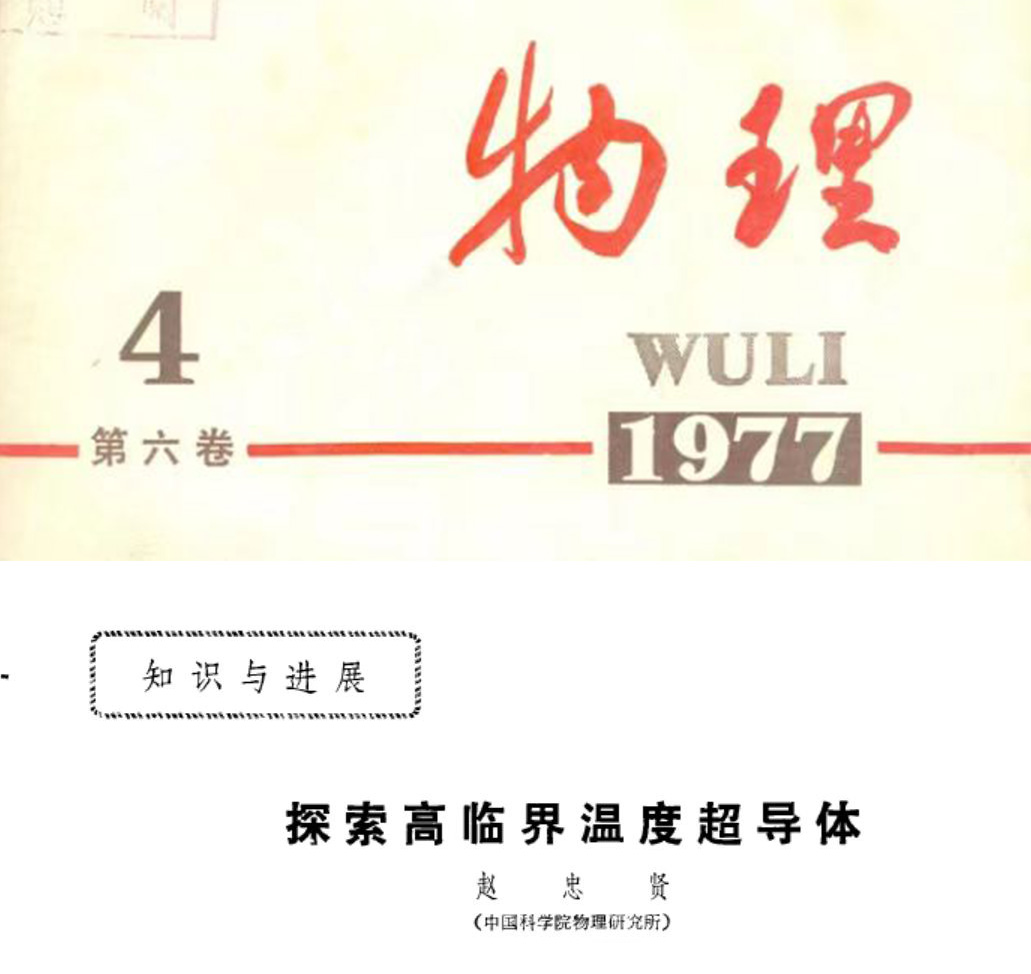
In 1977, Zhao Zhongxian published an article "Exploring High Critical Temperature Superconductors" in "Physics".
In 1977, 36-year-old Zhao Zhongxian wrote an article in the "Physics" magazine. He pointed out that the critical temperature of superconductors can reach 40-55K (about -233°C--218°C), and even 80K (about -192°C) in some cases. ℃).
Zhao Zhongxian was born in Xinmin, Liaoning in 1941, and was admitted to the Department of Technical Physics of USTC in 1959. "At that time, the teachers at USTC were very famous, such as Mr. Hua Luogeng in the Department of Mathematics, Mr. Qian Xuesen in the Department of Mechanics, and Yan Jici in the Department of Technical Physics. Mr. Guo Yonghuai is also the head of the department of HKUST.” Zhao Zhongxian recalled to reporters. In 1964, after graduating from the University of Science and Technology of China, he joined the Institute of Physics of the Chinese Academy of Sciences and has been engaged in research on low temperature and superconductivity. When this article was published, he had just returned from further studies at the University of Cambridge.
Zhao Zhongxian thought at the time that if we were limited to a few simple structures to explore, since there are so many elements on the earth, the path would not be wide, so we must start with complex structures. It's easy to say, but with so many compounds, it's like looking for a needle in a haystack.
Breakthrough: From the liquid helium temperature zone to the liquid nitrogen temperature zone, the first high-temperature superconductor was discovered
The turning point came nearly 10 years later.
At the end of September 1986, JGBednorz and KAMüller of the IBM Zurich Laboratory announced in an obscure academic journal that they had discovered barium lanthanum copper oxide at 35K (about -238.15°C) superconducting phenomenon in the environment. At that time, the international academic community had different opinions on this, and wondered whether this was another "crying wolf". But Zhao Zhongxian was keenly aware that this paper was different from the past, and started research on barium-lanthanum-copper oxides in early October.
"Because of our 10-year accumulation, we have realized the relationship between structural instability and high-temperature superconductivity. So when we saw the article by the Swiss scientists, we immediately resonated. We hurriedly repeated their results and wanted to Think about how to find a superconductor with a higher near temperature on this basis." Zhao Zhongxian said in an interview.
At that time, several laboratories in Japan and the United States were also trying. On November 13, 1986, the first news came from Japan. Professor Shoji Tanaka of the University of Tokyo confirmed the experimental results of Bednolds and Muller. All laboratories have entered into a state of fierce competition, striving to bring about more breakthrough progress.
In December 1986, Zhao Zhongxian and his colleagues also observed signs of superconducting transition with an initial temperature of 70K (about -203°C) in the lanthanum-barium-copper-oxygen system for the first time, which is already far away from the 77K (about -196°C) liquid The nitrogen temperature zone is not far away. The liquid nitrogen temperature range of -196°C means that the difficulty of refrigeration and the cost are greatly reduced. The price of liquid nitrogen is only a few tenths of that of liquid helium, and it can be bottled like a thermos.
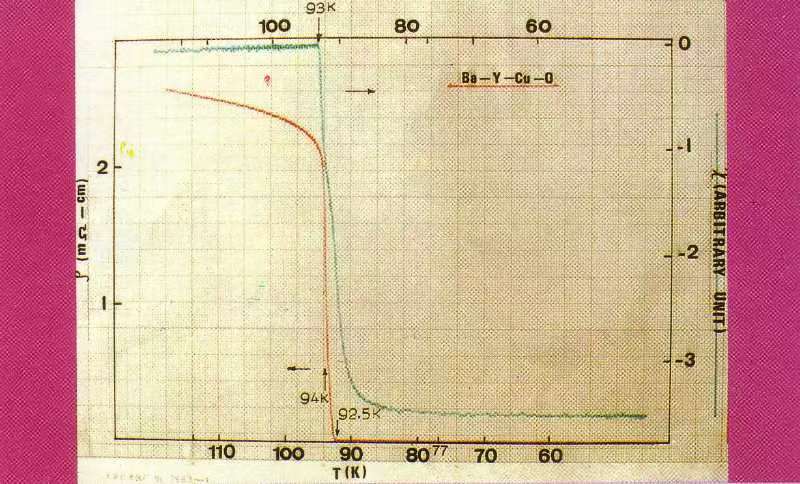
In 1987, the resistivity and AC magnetic susceptibility transition curves of Ba-Y-Cu-O superconducting materials.
The enthusiasm for searching for high-temperature superconductors around the world was once again ignited, and there have been frequent success reports since then. In the middle of the night of February 19, 1987, Zhao Zhongxian discovered a superconductor in the liquid nitrogen temperature region with a critical transition temperature of 93K (about -180°C) in yttrium barium copper oxide, and the experimental results can be repeated. Zhao Zhongxian has also become the "Zhao of Beijing" in the international physics community. His research has enabled cheap and easy-to-use liquid nitrogen to replace the original expensive liquid helium to create the low-temperature environment required for superconductivity.
Another breakthrough: the second type of high-temperature superconductor discovered
Since then, except for the metal and alloy superconductors, copper oxide superconductors, heavy fermion superconductors, and organic superconductors in the superconducting family, no new discoveries have been made, and the entire field has been silent again.
However, the discovery of high-temperature superconducting materials in 1986 changed the fate of a young man. Since then, he has continued to write new stories for the field of superconductivity. "At that time, there were several major research units in the field of superconductivity in China, including the Institute of Physics where Academician Zhao Zhongxian was located, the Department of Physics of the University of Science and Technology of China, Peking University, Nanjing University, etc." Chen Xianhui said, "Postgraduate students in Hangzhou At the time, it just caught up with the high-temperature superconductivity in 1986."
Chen Xianhui was born in Xiangtan, Hunan Province in March 1963. He took the college entrance examination and entered Yichun College in 1979. When he graduated, he was just 19 years old and entered middle school teaching. Chen Xianhui said, "At the beginning, I was carefree like a child." After going to Nanchang, Jiangxi and Hangzhou, Zhejiang, he had an idea at that time that he should not stay in Yichun anymore, he had to come out. Then he decided to take the postgraduate entrance examination and entered Hangzhou University.
Because of the breakthrough in the field of high-temperature superconductivity, Chen Xianhui, who was still a 24-year-old graduate student at Hangzhou University (now Zhejiang University), went to the laboratories of Qian Yitai and Chen Zuyao in the Department of Applied Chemistry of the University of Science and Technology of China to study as a joint master student. "Without high-temperature superconductivity, I would not be sitting here today to communicate with you. The high-temperature superconductivity in 1986 was an opportunity for me to develop to the present." Chen Xianhui's tone was not without emotion.
In February 2008, a Japanese scientist named Hideo Hosono announced the discovery of a new superconducting material, iron-arsenic compound LaOFeAs, which exhibits superconductivity at a critical temperature of 26K. The attraction of this study lies not in 26K (about -247.15°C), but in breaking the widely held view that iron means magnetism, which will only have a negative effect on the formation of superconductivity.
Since then, iron-based superconductors have been paid attention to. "Before 2008, there was only one type of unconventional high-temperature superconductor, that is, cuprate superconductors. However, in the past 22 years, the mechanism of cuprate superconductors and other related scientific issues cannot be clearly explained. If more types of high-temperature superconductors appear, Then by discovering their commonalities, we can better understand unconventional superconductors, that is, the type of superconductors that cannot be explained by BCS theory." Chen Xianhui said.
At the end of March, a breakthrough soon appeared. Chen Xianhui's team took the lead in raising the superconducting temperature of the SmFeAsO1-xFx system to 43K (-230.15°C) at normal pressure, breaking through the Macmillan limit of 40K for traditional superconductors.
Chen Xianhui said, "If the critical temperature of a superconductor is higher than 40K, it is a system that may not be explained by the BCS theory, and it may belong to an unconventional superconductor. Our work proves that the iron-based superconductor is the first high-temperature superconductor after the copper oxide. Two unconventional high-temperature superconductors , and there are only these two types so far."
Immediately afterwards, also at the end of March, Zhao Zhongxian's team successfully raised the superconducting transition temperature of iron-based superconductors to 52K in PrFeAsO1-xFx, and then achieved the highest temperature in iron-based superconductor bulk materials in SmFeAsO1-xFx in April. The transition temperature is 55K (-218.15°C) and a series of iron-based superconductors above 50K have been synthesized.
In 2008, the discovery of iron-based high-temperature superconductors (including the work of Japanese and Chinese scientists) was included in the top ten scientific and technological advances in the world selected by Science.
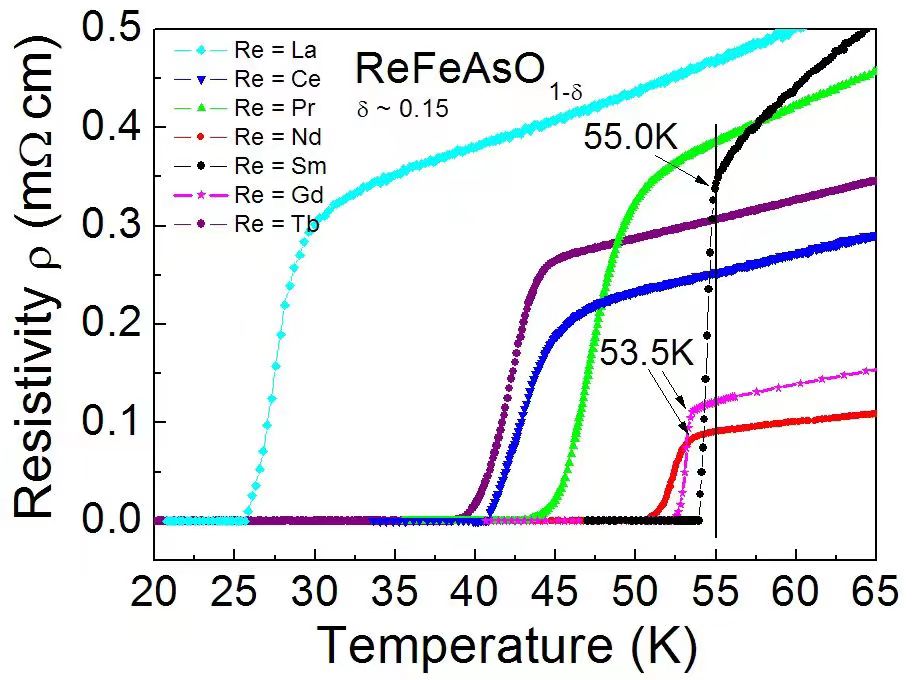
Resistance-temperature transition curves of a series of iron-based superconductors synthesized in 2008.
"From the critical temperature of 4.2K in 1911 to the high-temperature superconductor with a critical temperature of less than 24K (about -249.15°C) in 1986, it has been 75 years. That is to say, so many scientists have worked in this field for 75 years. Only increased the superconducting temperature by 20K. But after the discovery of the cuprate superconductor in 1986, the superconducting transition temperature under normal pressure has reached 132K (about -141.15°C). Compared with the previous 24K, it broke through at once. More than 100K." Chen Xianhui said in an interview.
In 2015, the Matthias Award, the highest award in international superconducting materials, was awarded to Zhao Zhongxian and Chen Xianhui.
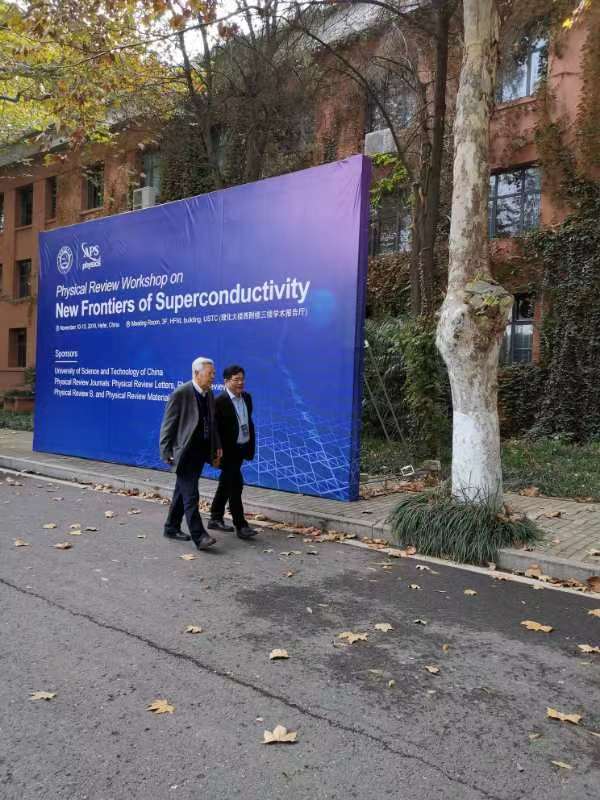
In November 2019, Zhao Zhongxian and Chen Xianhui participated in the "Superconducting New Frontier Seminar" at the University of Science and Technology of China.
"As a quantum material, superconductors, with their unique zero-resistance and complete diamagnetic properties, have brought about profound changes in the fields of energy, information, medical care, transportation and electricity, and have great application prospects." Future Science Award - Material Science Chen Xie, a member of the award committee and a professor of theoretical physics at the California Institute of Technology, said, "The transition temperature of traditional superconducting materials to superconducting state is very low (less than -230°C). The emergence of high-temperature superconducting materials has greatly improved the superconducting state. The temperature range in which the phenomenon can exist. On the one hand, this provides more possibilities for the large-scale application of superconducting materials, and at the same time reveals the complexity of the physical mechanism that forms the superconducting phenomenon."
The final holy grail: why room temperature superconductivity?
After 2008, scientists in the field of superconductivity began to challenge the ultimate "holy grail" - to find room temperature superconducting materials. Room temperature superconductivity refers to the phenomenon of superconductivity that occurs at room temperature or higher under normal pressure or close to normal pressure, known as the "holy grail" of physics.
Superconducting materials have two characteristics - zero resistance and complete diamagnetism. Zero resistance means that the current passes through the superconductor without energy consumption, and the resistance is zero. "From the perspective of materials, it is not only an energy material, but also an information material." Chen Xianhui said, " Our current technological development is mainly in three categories, one is energy, information, and biotechnology. Superconducting materials can be Supporting energy technology can also support information technology, which has a wide range of applications, such as nuclear magnetic resonance and superconducting maglev trains. In science, the temperature of controllable nuclear fusion is above hundreds of millions of degrees. There is no material to restrain it, so the main With superconductivity, the acceleration and control of electrons used in the accelerator of the Tokmak nuclear fusion experimental device also need superconductivity."
And if the superconducting state at normal pressure and room temperature can be realized, then it can get rid of the shackles of the cooling system and truly use superconducting technology on a large scale. "If room-temperature superconductivity is discovered, the changes it will bring to people's lives will be earth-shaking. By that time, we will be able to sit in a suspended superconducting car when we go out, and even mobile phones and laptops can be used for several months on a single charge. " Chen Xianhui imagined, "Human civilization can be divided by materials, and room-temperature superconducting materials can become the symbolic materials for dividing the civilization period of human society."
This is also the reason why every time a team claims to have discovered a superconducting material at room temperature at normal pressure, it is easy to attract widespread attention. For example, the recent Korean Quantum Energy Research Center Corporation and related teams announced that the copper-doped lead apatite material LK-99 can achieve room temperature superconductivity.
"It can be noticed that when LK-99 came out, many people expressed their opinions on it, and those who spoke out were basically people who did not really do superconducting physics, and professionals must be cautious. Although professionals seldom speak, but Many scientists in this field are repeating their results." Chen Xianhui did not express his opinion directly, but he also revealed his attitude.
He said, "The significance of publishing scientific papers is to have an accurate grasp of the published results, and to publish them under credible and repeatable circumstances. The Korean team is in such a hurry this time, it is obvious that the stage is not rigorous enough. properties or not yet fully confirmed conclusions have been thrown out.” He also added, “Of course, if the result is true, it is indeed a great progress for human beings, because whether it is room temperature superconductivity or so high temperature (about 127 degrees Celsius)."
Zhao Zhongxian responded more directly to the reporter's question, "I don't think this work has anything to do with superconductivity. I think the explanation of the related work of Luo Jianlin's group at the Institute of Physics (Chinese Academy of Sciences) is relatively clear. Doing scientific research must Be cautious, don't rush. This paper has no academic impact on me, as long as I don't get disturbed."
"I think that in order to find room-temperature superconductors, we need to start with a new mechanism. This is a direction we are working on now." Zhao Zhongxian told The Paper (www.thepaper.cn).
